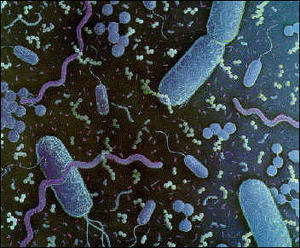InfrastructureUsing bacteria to create self-healing concrete
Cement production has an impact on the environment as it is very energy intensive, accounting for about 7 percent of the total anthropogenic atmospheric CO2 emissions; in addition to the energy consumption from production and transportation, air pollution, as well as land use and impacts on the landscape from related mining activities are also matters of concern; means of increasing the service life of concrete structures would make the material not only more durable, but also more sustainable — and researchers find that embedding certain bacteria in the concrete promises to do just that

Alkaline-resistant bacteria may make concrete longer-lived // Source: wibuilder.com
Some types of bacteria show the potential to act as self-healing concrete, according to a recent study. This could make the construction material more durable and therefore more sustainable.
Typically, concrete consists of 300kg of cement, 180 liters of water, and 1890kg of aggregates per m3. Cement production has an impact on the environment as it is very energy intensive, accounting for about 7 percent of the total anthropogenic atmospheric CO2 emissions. In addition to the energy consumption from production and transportation, air pollution, as well as land use and impacts on the landscape from related mining activities are also matters of concern. Therefore, means of increasing the service life of concrete structures would make the material not only more durable, but also more sustainable.
Today’s Concrete Technology reports that concrete structures are susceptible to cracking which allows water and damaging chemicals to enter and degrade the concrete, reducing the durability of the structure as well as requiring costly maintenance and repairs. This study, conducted by Dutch researchers, explored the effects of adding bacteria into the concrete mixture, when it is manufactured, which could encourage minerals to fill in cracks later on in its life.
Bacteria added to concrete mixtures before application should meet certain criteria: fresh concrete is highly alkaline, so bacteria should be able to tolerate alkaline conditions for long periods the bacteria should be able to form spores (highly resistant structures) in order to withstand large mechanical forces during mixing and to maintain strength and structure within the concrete small holes (pores) develop in the setting concrete that allow oxygen to enter the mixture, therefore suitable bacteria must be oxygen tolerant
In the laboratory, a series of concrete mixtures were prepared containing bacterial spores from two species of the alkali-resistant bacteria Bacillus (B. pseudofirmus and B. cohnii) , isolated from alkaline soil samples, and one of four different organic compounds from which the bacteria could potentially produce ‘biominerals’. After the specimens were allowed to cure (set) for a given time, they were broken up, put into water and checked to see if minerals had formed in fresh surface cracks.
Of the organic compounds tested with the bacteria, only bacteria and calcium lactate indicated that they may be able to self heal concrete cracks.
This effect, however, seems to be limited to young concrete. Relatively large solid minerals (20-80 µm) were produced extensively on the cracks of young specimens (7 days), but only smaller-sized minerals (2-5 µm) were seen on the cracks of 28 day-old samples. The minerals are probably calcium carbonate-based and formed when the bacteria converts calcium lactate.
As the cement aged, the size of the pores inside the cement mixture decreased; from larger pores (0.1-1 µm) in young samples, cured for 3 or 7 days, to smaller pores (0.01-0.1 µm) in older specimens cured for 28 days. The decreasing pore size was probably responsible for the loss of spore strength: the larger pore sizes can contain bacterial spores, typically 0.8-1 µm in diameter, but the spores would be crushed by smaller holes. No strong spores were detected in a 135-day old specimen, implying the majority of spores in the cured cement mixture were suitable for less than 4 months.
Today’s Concrete Technology reports that further research is needed to increase the time period that the bacterial spores remain in the concrete. It could be possible, for example, to protect the spores by encasing them in another material, such as a silica sol-gel, before adding to the concrete mixture creating self healing concrete.
